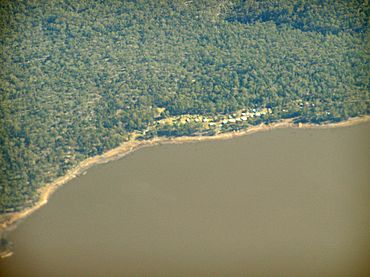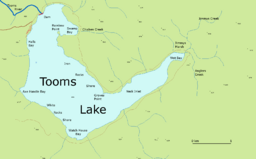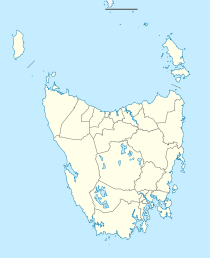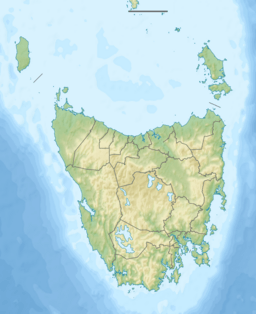Tooms Lake facts for kids
Quick facts for kids Tooms LakeTasmania |
|||||||||||||||
|---|---|---|---|---|---|---|---|---|---|---|---|---|---|---|---|

Aerial photo from the east, the village is at the top of the lake
|
|||||||||||||||
| Population | nil (2016) | ||||||||||||||
| Postcode(s) | 7209 | ||||||||||||||
| Elevation | 464 m (1,522 ft) | ||||||||||||||
| Location | |||||||||||||||
| LGA(s) | Northern Midlands, Southern Midlands, Glamorgan-Spring Bay | ||||||||||||||
| Region | Central, South-east | ||||||||||||||
| State electorate(s) | Lyons | ||||||||||||||
| Federal Division(s) | Lyons | ||||||||||||||
|
|||||||||||||||
| Tooms Lake | |
|---|---|

map with settlement
|
|
| Location | Tasmania |
| Coordinates | 42°13′55″S 147°47′46″E / 42.232°S 147.796°E |
| Lake type | reservoir |
| Primary inflows | Jimmys Creek |
| Primary outflows | Tooms River |
| Catchment area | 60.2 km2 (23.2 sq mi) |
| Basin countries | Australia |
| Surface area | 6.6 km2 (2.5 sq mi) |
| Water volume | 25.362 gigalitres (895,700,000 cu ft) |
| Surface elevation | 468 m (1,535 ft) |
| Frozen | no |
| Islands | none |
Tooms Lake is a special place in Tasmania, Australia. It is both a small community area and a lake. This area is located in the central and south-east parts of Tasmania.
The locality of Tooms Lake is about 47 kilometers (29 miles) north of the town of Triabunna. According to the 2016 census, no one lives permanently in the Tooms Lake area.
The lake itself is not natural. It was created by people and is quite shallow. It covers an area of about 6.6 square kilometers (2.5 square miles).
Contents
About Tooms Lake
Tooms Lake was once a natural wetland area. It was an important meeting place for the Tasmanian Aboriginal people. They called this place moyantaliah, which sounds like moy-en-tel-eea.
The lake can hold a lot of water. It can store about 25.362 gigaliters of water. That's a huge amount!
Fun Activities at Tooms Lake
Tooms Lake is a popular spot for fishing. People often come here to catch brown and rainbow trout. These types of trout were first brought to the lake a long time ago. Brown trout were introduced in 1904, and rainbow trout around 1908.
- Most trout caught here weigh between 1 and 1.5 kilograms (2.2 to 3.3 pounds).
- The biggest trout found can weigh up to 2.5 kilograms (5.5 pounds).
Other interesting creatures live in Tooms Lake too. One example is the jollytail fish.
Exploring for Energy
A company called Kuth Energy is drilling in the Tooms Lake area. They are looking for geothermal energy. This is a type of energy that comes from the heat inside the Earth. Their exploration hole is called Tooms1.
Visitor Information
If you visit Tooms Lake, there are a few things you can find.
- You can use the camping ground if you want to stay overnight.
- There is a boat ramp to launch boats onto the lake.
- Public toilets and rubbish bins are available.
- However, there are no shops or public phones in the area. So, make sure you bring everything you need!
The lake is located 468 meters (1,535 feet) above sea level.
History of Tooms Lake
Tooms Lake has a long history, including some sad events.
Early History and Conflict
On December 6, 1828, a difficult event happened involving Tasmanian Aboriginal people and soldiers. Ten Aboriginal people were killed by nine soldiers from the 40th regiment.
John Danvers, who was with the soldiers, reported what happened. He said that the Aboriginal group was discovered and tried to defend themselves. The soldiers then fired their weapons. About twenty Aboriginal people were there, and several were killed. Two, a woman and a boy, were captured, and the rest managed to escape.
Building the Dam
The dam that created Tooms Lake was built by 40 men. This dam helped to form the lake as we know it today.
Geography of Tooms Lake
The Little Swanport River forms part of the southern edge of the Tooms Lake area. The lake itself is completely inside the Tooms Lake locality.



